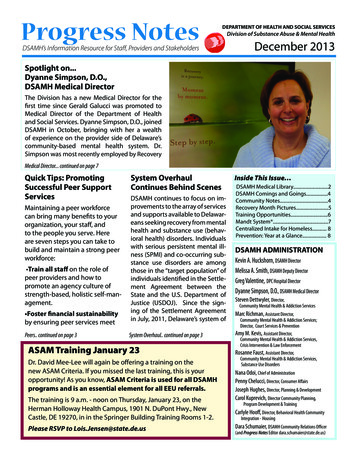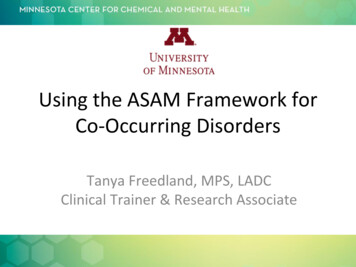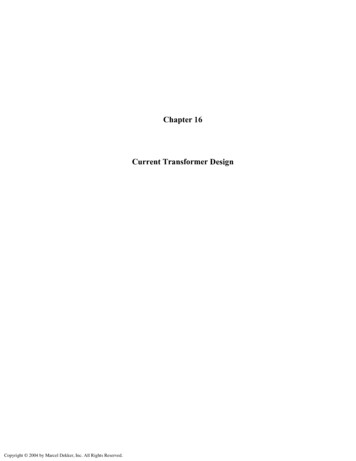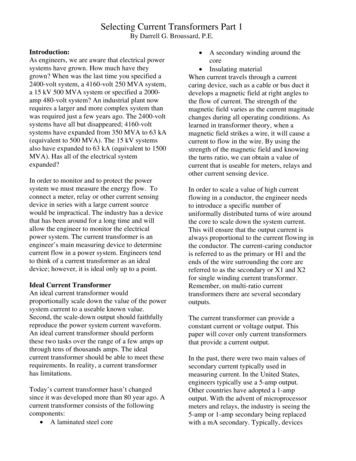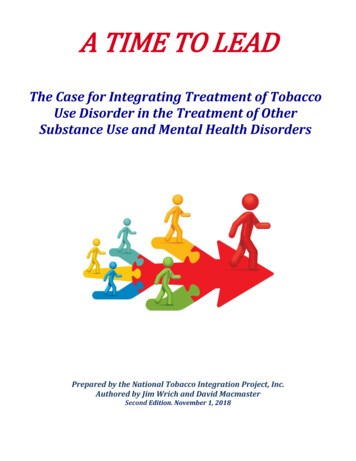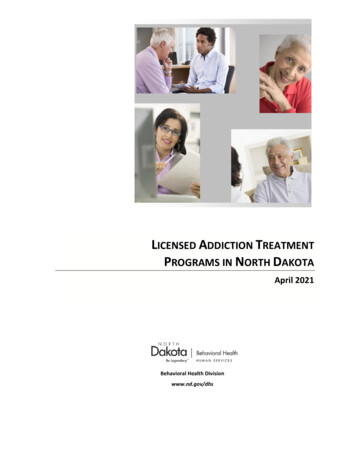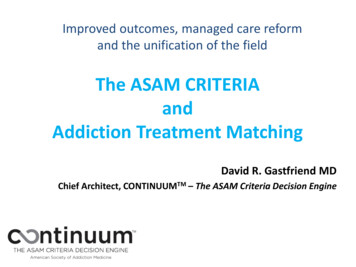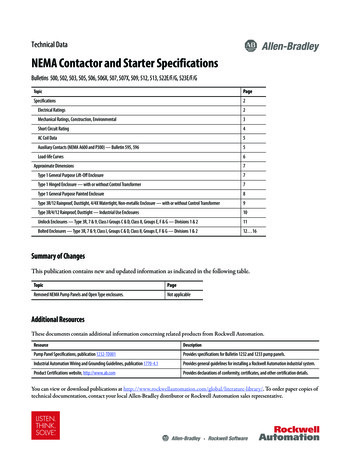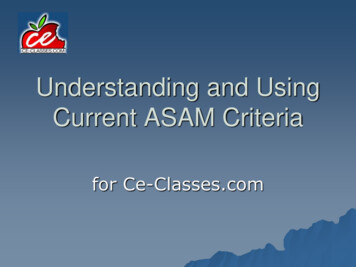
Transcription
Understanding and UsingCurrent ASAM Criteriafor Ce-Classes.com
Learning Objectives Aftercompleting this course,participants will: IdentifyASAM and the history of itsdevelopment Describe how ASAM criteria fit into theassessment process Identify ASAM Levels of Care Describe ASAM Dimensional Criteria2
The 3rd Edition of the ASAMCriteria3
Overview of Training What is ASAM and the history of itsdevelopment How ASAM fits into the assessment process Levels of Care Dimensional Criteria4
ASAM Criteria BackgroundIn the late 1980’s a taskforce isassembled to integrate existing admissionand continued stay criteria Both NAATP and ASAM were involved Ownership of the criteria was left withASAM Retrieved from: easam-criteria-222058615
ASAM Criteria Background Goal - unifying the addiction field to asingle set of criteriaRetrieved from: easam-criteria-222058616
ASAM Criteria Background The criteria were developed through acollaborative process in which consensuswas achievedClinical experts, researchers and acoalition of stakeholders were included inthe processRetrieved from: easam-criteria-222058617
ASAM Criteria Background The edition with which most practitionersare familiar is the Patient PlacementCriteria-2R (2001) which replaced the1996 versionA new edition came out in the Fall of 2013Retrieved from: easam-criteria-222058618
ASAM Criteria Background The ASAM criteria are guidelines for:–––––AssessmentService planningPlacementContinued stayDischarge Forclients with substance abusedisordersRetrieved from: easam-criteria-222058619
ASAM Criteria Background The ASAM criteria is a framework forpatient assessment that ismultidimensionalRetrieved from: easam-criteria-2220586110
ASAM Criteria Background The ASAM criteria is also a description oflevels of care– Levels of care refers to the places withinthe service continuum from outpatientto intensive inpatient treatment.Retrieved from: easam-criteria-2220586111
ASAM Criteria Background The ASAM criteria provides a means fordeciding upon the appropriate intensity ofservice based upon the patient’s severityof illnessRetrieved from: easam-criteria-2220586112
When to use ASAM At first contact with client (at assessment,when referral is made, to see if a referral isappropriate for your program)During treatment– If not doing well– If achieving goalsAt discharge– To see what the client needs nextPosze, L . ASAM PPC-2R Patient Placement Criteria 10113
How to Use the Criteria Toassign the appropriate level ofservice and level of care. To make decisions about continuedservice or discharge by ongoingassessment and review of progress. To do effective treatment planningand documentation.14
ASAM CriteriaBasic Concepts The main goal of the system is to provideindividualized – clinically driven –treatmentRetrieved from: easam-criteria-2220586115
ASAM CriteriaBasic ConceptsRetrieved from: easam-criteria-2220586116
ASAM CriteriaBasic ConceptsRetrieved from: easam-criteria-2220586117
ASAM CriteriaBasic Concepts Eachelement of the process informsthe next Thisis a cyclical processRetrieved from: easam-criteria-2220586118
ASAM Criteria Background Intensityof Service is often referred Severityof Illness is often referred toto as ISas SIRetrieved from: easam-criteria-2220586119
ASAM’s New Definition ofAddiction Addiction is a primary, chronic disease ofbrain reward, motivation, memory andrelated circuitry. Dysfunction in thesecircuits leads to characteristic biological,psychological, social and spiritualmanifestations. This is reflected in anindividual pathologically pursuing rewardand/or relief by substance use and otherbehaviors.ASAM (2011). Public Policy Statement: Definition ofAddiction20
ASAM’s New Definition ofAddiction Addiction is characterized by inability toconsistently abstain, impairment inbehavioral control, craving, diminishedrecognition of significant problems withone’s behaviors and interpersonalrelationships, and a dysfunctionalemotional response. Like other chronicdiseases, addiction often involves cycles ofrelapse and remission. Without treatmentor engagement in recovery activities,addiction is progressive and can result indisability or premature death.ASAM (2011). Public Policy Statement: Definition ofAddiction21
Definition of Other Key Terms Clinicallymanaged: Directed by nonphysician addiction specialist ratherthan medical personnel. Appropriatefor individuals whose primary problemsinvolve emotional, behavioral,cognitive, readiness to change, relapseor recovery environment s are all minimal if they exist atall.Shulman & Associates. (2007). American Society of AddictionMedicine (ASAM) How and When to Use the Criteria.22
Definition of Terms MedicallyMonitored: Servicesprovided by an interdisciplinary staff ofnurses, counselors, social workers,addiction specialist and other healthand technical personnel under thedirection of a licensed physician.Medical monitoring is provided throughappropriate mix of direct patientcontact, review of records, teammeetings, 24 hour coverage by aphysician and a quality assuranceprogram.Shulman & Associates. (2007). American Society of AddictionMedicine (ASAM) How and When to Use the Criteria.23
Definition of Terms MedicallyManaged: Services thatinvolve daily medical care, wherediagnostic and treatment servicesare directly provided and/ormanaged by an appropriately trainedand licensed physician.Shulman & Associates. (2007). American Society of AddictionMedicine (ASAM) How and When to Use the Criteria.24
Dimensional Assessment ASAM Criteria should be utilized to:– Determine the appropriate level of service andlevel of care– Conduct effective treatment planning anddocumentation– Make choices about continued service ordischarge through ongoing assessment andreview of progress notesShulman & Associates. (2007). American Society of AddictionMedicine (ASAM) How and When to Use the Criteria.25
Dimensional Assessment Dimension 1: Acute Intoxication/WithdrawalPotentialDimension 2: Biomedical Conditions andComplicationsDimension 3: Emotional/Behavioral/CognitiveConditions and ComplicationsDimension 4: Readiness to ChangeDimension 5: Relapse/Continued Use/ContinuedProblem PotentialDimension 6: Recovery EnvironmentShulman & Associates. (2007). American Society of AddictionMedicine (ASAM) How and When to Use the Criteria.26
ASAM CriteriaAssessment Assessment of Biopsychosocial Severityand Level of FunctionThis is the first step in the processRetrieved from: easam-criteria-2220586127
Assessment of Severity &Level of Function First identify if there is acute intoxicationand/or withdrawal potentialRetrieved from: easam-criteria-2220586128
Assessment of Severity &Level of Function Evaluate– Biomedical conditions & complications– Behavioral conditions & complications– Cognitive conditions & complicationsRetrieved from: easam-criteria-2220586129
Assessment of Severity &Level of Function Evaluate– Readiness to change– Relapse/continued use potential– Recovery environmentRetrieved from: easam-criteria-2220586130
What is ASAM PPC? ThePatient Placement Criteriaprovide:– A tool to use along with your clinicaljudgment– Criteria for how bad the problem is andwhat the client needs– A framework for determining who needswhat level of care– Standard descriptions of levels of careand who might need themPosze, L . ASAM PPC-2R Patient Placement Criteria 10131
Client-Directed, OutcomeInformed Enhances efficient use of limited resourcesVariable length of stay determined by client need andprogressCan increase retention and reduce drop outs and relapseBroad flexible levels of care, such as mixing IOP andhousing to get a residential type programCreative use of resources to develop a treatment packagefor each clientClient and clinician have a choice about treatment levels –least intensive while safe and effectiveCan enter the system at any level of care and move asneededIf there are limited levels of care in your area, link withother providers as needed32
The Heart of Client-Directed Tx Builda therapeutic alliance it isthe greatest determinant oftreatment outcome33
The Heart of Client-Directed Tx Cometo agreement with yourclient about the treatment–Goals–Strategies–Methods34
The Heart of Client-Directed Tx Ifthe client is not with you, yourtreatment will not be effective Helpthe client accomplish whatis important to them, which willlikely involve staying clean andsober35
The Heart of Client-Directed Tx Court-orderedor leveragedtreatment can be effective Thegoal may be to satisfy thecourt order!36
AssessmentWhat does the client want? Why now?2. Multidimensional assessment includingstrengths, supports, resources, risks anddeficits3. Imminent danger– Relates to all dimensions– Immediate Need Profile– Risks that require immediate attentionConsider the 3 H’s– History– Here and now– How concerned are youPosze, L . ASAM PPC-2R Patient Placement Criteria 1011.37
The Three H’s of Assessment History Hereand Now Howuncomfortable are you?38
Rating Risk in the 6 Dimensions0 – no or very low risk. Stable.1 – mild discomfort, can be stabilized, functioningrestored easily2 – moderate risk/difficulty functioning but canunderstand support services3 – serious difficulties – in or near imminent danger4 – highest concern – severe, persistent, poor abilityto cope with illness, life threatening Can also rate as LOW, MEDIUM, andHIGHPosze, L . ASAM PPC-2R Patient Placement Criteria 10139
How do the Dimensions leadto a level of care? Dimensions 1, 2 and 3 – high risk/severity immediate need for high intensity services Dimensions 4, 5, and 6 – balance outstrengths and challenges in these dimensionsinteract – combine and contrast to determinethe lowest intensity service level that is safeand effective for the client (and others)Posze, L . ASAM PPC-2R Patient Placement Criteria 10140
Dimension 1 – AcuteIntoxication/Withdrawal Whatrisk is associated with thepatient’s current level of acuteintoxication? Are there current signs ofwithdrawal? Does the patient have supports toassist in ambulatory detoxification, ifmedically safe?Lee, Editor (2001) ASAM PPC-2R, ASAM Patient Placement Criteriafor the Treatment of Substance Related Disorders, 2nd Ed Revised,41
Dimension 1 – AcuteIntoxication/Withdrawal Isthere significant risk of severewithdrawal symptoms or seizures,based on the patients previouswithdraw history, amount, frequencychronicity and recent discontinuationor significant reduction of alcohol orother drug use.Lee, Editor (2001) ASAM PPC-2R, ASAM Patient Placement Criteriafor the Treatment of Substance Related Disorders, 2nd Ed Revised,42
Matching assessment ofseverity with level of careAssessment of Severity 0 no intoxication orwithdrawal or alreadyresolvedLevel of Care Does not affectplacementPosze, L . ASAM PPC-2R Patient Placement Criteria 10143
Matching assessment ofseverity with level of careAssessment of Severity 1 minimum tomoderate intoxicationor withdrawal withminimal riskLevel of Care Level 1D – outpatient(some onsitemonitoring)Posze, L . ASAM PPC-2R Patient Placement Criteria 10144
Matching assessment ofseverity with level of careAssessment of Severity 2 has some difficultycoping with moderateintoxication orwithdrawal, some riskof more serioussymptomsLevel of Care Level 2D – outpatient(extended onsitemonitoring)Posze, L . ASAM PPC-2R Patient Placement Criteria 10145
Matching assessment ofseverity with level of careAssessment of Severity 3 has significantdifficulty coping withsevere signs andsymptoms ofintoxication orwithdrawal, risk ofmore severesymptomsLevel of Care Level 3.2D –residential (socialsetting detox) orLevel 3.7D (socialsetting detox withmedication support)Posze, L . ASAM PPC-2R Patient Placement Criteria 10146
Matching assessment ofseverity with level of careAssessment of Severity 4 incapacitated withsevere signs andsymptoms, continueduse poses cleardanger, withdrawalposes clear dangerLevel of Care Level 4D – inpatient(hospital)Posze, L . ASAM PPC-2R Patient Placement Criteria 10147
Dimension 2: BiomedicalConditions & Complications Are there current physical illnesses, other thanwithdrawal, that need to be addressed becausethey create risk or complicate treatment?Are there chronic conditions that affecttreatment?Lee, Editor (2001) ASAM PPC-2R, ASAM Patient Placement Criteriafor the Treatment of Substance Related Disorders, 2nd Ed Revised,48
Dimension 2: BiomedicalConditions & Complications Hypertension, cardiac disorders, vasculardisorders, diabetes, and seizure disorders are allhigh on the listChronic benign pain syndromes are often anissue There are a range of chronic disorders that mayneed to be considered in placement decisionsLee, Editor (2001) ASAM PPC-2R, ASAM Patient Placement Criteriafor the Treatment of Substance Related Disorders, 2nd Ed Revised,49
Matching assessment ofseverity with level of careAssessment of Severity 0: no biomedicalproblemsLevel of Care Does not affectplacementPosze, L . ASAM PPC-2R Patient Placement Criteria 10150
Matching assessment ofseverity with level of careAssessment of Severity 1 adequate ability tocope, mild to moderatesigns and symptomsLevel of Care Level 1Posze, L . ASAM PPC-2R Patient Placement Criteria 10151
Matching assessment ofseverity with level of careAssessment of Severity 2 some difficulty coping,problems may interferewith treatment, fails tocare for seriousbiomedical problemsLevel of Care Level 1, 2 or 3Posze, L . ASAM PPC-2R Patient Placement Criteria 10152
Matching assessment ofseverity with level of careAssessment of Severity 3 poor ability to copewith serious biomedicalproblemsLevel of Care Level 4Posze, L . ASAM PPC-2R Patient Placement Criteria 10153
Matching assessment ofseverity with level of careAssessment of Severity 4 incapacitated withsevere biomedicalproblemsLevel of Care Level 4Posze, L . ASAM PPC-2R Patient Placement Criteria 10154
Dimension 3: Emotional, Behavioral, orCognitive Conditions & Complications Are there current psychiatric illnesses orpsychological, behavioral, emotional, orcognitive problems that need to beaddressed because they create risk orcomplicate treatment?Are there chronic conditions that affecttreatment?Do any emotional, behavioral, orcognitive problems appear to be anexpected part of the addictive disorder,or do they appear to be autonomous?Lee, Editor (2001) ASAM PPC-2R, ASAM Patient Placement Criteriafor the Treatment of Substance Related Disorders, 2nd Ed Revised,55
Dimension 3: Emotional, Behavioral, orCognitive Conditions & Complications Evenif connected with the addictivedisorder, are they severe enough towarrant specific mental healthtreatment? Is the individual capable ofmanaging the activities of dailyliving? Does the individual have theresources to cope with theemotional, behavioral, or cognitiveproblems?Lee, Editor (2001) ASAM PPC-2R, ASAM Patient Placement Criteriafor the Treatment of Substance Related Disorders, 2nd Ed Revised,56
Matching assessment ofseverity with level of careAssessment of Severity 0 no emotional ormental health problemor if it exists, it isstableLevel of Care Does not affectplacementPosze, L . ASAM PPC-2R Patient Placement Criteria 10157
Matching assessment ofseverity with level of careAssessment of Severity 1 diagnosed mentaldisorder requiringintervention but does notinterfere with treatmentLevel of Care Level 1Posze, L . ASAM PPC-2R Patient Placement Criteria 10158
Matching assessment ofseverity with level of careAssessment of Severity 2 persistent mentalillness with symptomsthat interfere withtreatment but do notconstitute immanent riskLevel of Care Level 2Posze, L . ASAM PPC-2R Patient Placement Criteria 10159
Matching assessment ofseverity with level of careAssessment of Severity 3 serious symptoms,disability, and impulsivitybut not requiringinvoluntary hospitalizationLevel of Care Level 3Posze, L . ASAM PPC-2R Patient Placement Criteria 10160
Matching assessment ofseverity with level of careAssessment of Severity 4 serious symptoms,disability and impulsivityrequiring involuntaryhospitalization.Level of Care Level 4Posze, L . ASAM PPC-2R Patient Placement Criteria 10161
Dimension 4- Readiness /Motivation Whatis the individual’s emotionaland cognitive awareness of the needto change? What is his or her level ofcommitment to and readiness forchange?Lee, Editor (2001) ASAM PPC-2R, ASAM Patient Placement Criteriafor the Treatment of Substance Related Disorders, 2nd Ed Revised,62
Dimension 4- Readiness /Motivation Whatis or has been his or herdegree of cooperation withtreatment? What is his or her awareness of therelationship of alcohol or other druguse to negative consequences?Lee, Editor (2001) ASAM PPC-2R, ASAM Patient Placement Criteriafor the Treatment of Substance Related Disorders, 2nd Ed Revised,63
Dimension 4: Readiness to Change Pre-contemplation:does notknow they have a problem. “Indenial.” Avoids thinking abouttheir behavior. Risk rating: 4Posze, L . ASAM PPC-2R Patient Placement Criteria 10164
Dimension 4: Readiness to Change Contemplation:aware ofproblem but ambivalent. Teeterbetween cost and benefit ofcontinued use. Risk rating: 3Posze, L . ASAM PPC-2R Patient Placement Criteria 10165
Dimension 4: Readiness to Change Preparation:intending to takeaction in the immediate futureRisk rating: 2Posze, L . ASAM PPC-2R Patient Placement Criteria 10166
Dimension 4: Readiness to Change Action:specific overt changeshave been made in the last 6months to reduce risk. Riskrating: 1Posze, L . ASAM PPC-2R Patient Placement Criteria 10167
Dimension 4: Readiness to Change Maintenance:achieved changegoals for 6 months. Riskrating: 0Posze, L . ASAM PPC-2R Patient Placement Criteria 10168
Matching assessment of severity withlevel of care Notas direct a correlation betweenDimensions 4, 5, and 6 and levels ofcare May need to use motivationalstrategies to attract them intotreatment Resistance is expected and does notexclude clients from treatmentPosze, L . ASAM PPC-2R Patient Placement Criteria 10169
Matching assessment of severity withlevel of care Ifrisk is low in other dimensions,may work on increasing motivationin a lower level of care first toprepare for treatment: a “discoveryplan”Posze, L . ASAM PPC-2R Patient Placement Criteria 10170
Matching assessment of severity withlevel of care Ifhigh risk/severity in otherdimensions, may need to “contain”the client and do motivationalenhancement in a higher level ofcare Lookfor strengthsPosze, L . ASAM PPC-2R Patient Placement Criteria 10171
Dimension 5: Relapse, Continued Useor Continued Problem Potential Isthe patient in immediate danger ofcontinued severe mental healthdistress and or alcohol and drug use? How aware is the patient of relapsetriggers, ways to cope with cravingsto use, and skills to control impulsesto uses or impulses to harm self orothers?Lee, Editor (2001) ASAM PPC-2R, ASAM Patient Placement Criteriafor the Treatment of Substance Related Disorders, 2nd Ed Revised,72
Dimension 5: Relapse, Continued Useor Continued Problem Potential Doesthe patient have anyrecognition of, understanding of, orskills with which to cope with his orher addictive or mental disorder inorder to prevent relapse, continueduse or continued problems such assuicidal behavior?Lee, Editor (2001) ASAM PPC-2R, ASAM Patient Placement Criteriafor the Treatment of Substance Related Disorders, 2nd Ed Revised,73
Dimension 5: Relapse, ContinuedUse or Continued Problem Potential Relapse:stops using on purposeand begins again Continueduse: never stops usingto begin withPosze, L . ASAM PPC-2R Patient Placement Criteria 10174
Dimension 5: Relapse, ContinuedUse or Continued Problem Potential Wouldcontinued use/relapse bedangerous to the client or to others– Children– Other adults in their lives– Others in the worldPosze, L . ASAM PPC-2R Patient Placement Criteria 10175
Dimension 5: Relapse, ContinuedUse or Continued Problem Potential Howsevere are the problems if theindividual is not successfully engagedin treatment at this time?Posze, L . ASAM PPC-2R Patient Placement Criteria 10176
Dimension 5: Relapse, ContinuedUse or Continued Problem Potential Howaware is the individual of relapsetriggers:– Ways to cope with cravings to use,– Skills to control impulses to use or,– Impulses to harm self or others?Posze, L . ASAM PPC-2R Patient Placement Criteria 10177
Matching assessment of severity withlevel of care Have to consider in relation to otherdimensionsHigh severity can indicate need for higherintensity of services but not necessarilyConsider the lowest intensity that is safeand effectivePosze, L . ASAM PPC-2R Patient Placement Criteria 10178
Dimension 6: Recovery/LivingEnvironment Assess for risks, issues, strengths, skills, andresources in:– Recovery supports– Living environment– Family, friends, social network– Work/school– Finances– Transportation– Legal mandates/requirementsPosze, L . ASAM PPC-2R Patient Placement Criteria 10179
Matching assessment of severitywith level of care Consider in relation to other dimensionsHigh severity can indicate need for higherintensity of services but not necessarilyConsider the lowest intensity that is safe andeffectivePosze, L . ASAM PPC-2R Patient Placement Criteria 10180
Continued TreatmentGuidelines Keep the client in the current level ofcare if:– They are making progress but have not yet achievedtheir goals– They are not yet making progress but have thecapacity to resolve their problems, are activelyworking on goals, and continued treatment isnecessary to reach their goals– New problems have been identified that can betreated at this levelPosze, L . ASAM PPC-2R Patient Placement Criteria 10181
Discharge & Transfer CriteriaConsider transferring if:– They have achieved their goals andresolved the problem (transfer to alower level of care)– They are unable to resolve theproblem despite adjustments to thetreatment plan (increase level of care)Posze, L . ASAM PPC-2R Patient Placement Criteria 10182
Discharge & Transfer CriteriaConsider transferring if:– They demonstrate a lack of capacity toresolve the problems (increase level ofcare)– If their problems get worse or– If more problems emerge that can’t beeffectively treated at this level of care(increase level of care)Posze, L . ASAM PPC-2R Patient Placement Criteria 10183
Discharge Planning Discharge planning is part of treatmentplanningIt isn’t a separate or isolated activityShulman & Associates. (2007). American Society of AddictionMedicine (ASAM) How and When to Use the Criteria.84
Discharge Planning A discharge plan is really a deferredtreatment planIt should be as specific and concrete asany other treatment planShulman & Associates. (2007). American Society of AddictionMedicine (ASAM) How and When to Use the Criteria.85
Levels of Service Eachlevel of care has specificparameters which define it86
Outpatient with Supportive Living Providesstructure and support Primarymedical services notnecessary Patientsnot in “Imminent Danger”Shulman & Associates. (2007). American Society of AddictionMedicine (ASAM) How and When to Use the Criteria.87
Residential Treatment Provides24 hour:– Structure and support (except 3.1 24hours) Primarymedical services notnecessary Patientsin “Imminent Danger”Shulman & Associates. (2007). American Society of AddictionMedicine (ASAM) How and When to Use the Criteria.88
Inpatient Treatment Provides24 hour:– Structure and support– Access to medical & nursing services Patientsin “Imminent Danger”Shulman & Associates. (2007). American Society of AddictionMedicine (ASAM) How and When to Use the Criteria.89
What is Imminent Danger?A strong probability that certain behaviorswill occur (e.g., continued alcohol or druguse or non-compliance with psychiatricmedications) These behaviors will present a significantrisk of serious adverse consequences tothe individual and/or others (as in aconsistent pattern of driving whileintoxicated) The likelihood that such adverse eventswill occur in the very near future Shulman & Associates. (2007). American Society of AddictionMedicine (ASAM) How and When to Use the Criteria.90
What is Imminent Danger? Inorder to constitute “ImminentDanger” ALL THREE ELEMENTSmust be presentShulman & Associates. (2007). American Society of AddictionMedicine (ASAM) How and When to Use the Criteria.91
Imminent Danger RequiresIn-patient treatmentShulman & Associates. (2007). American Society of AddictionMedicine (ASAM) How and When to Use the Criteria.92
Immediate Need Acriteria to be considered indetermining level of care93
Immediate Need Profile Dimension #1: AcuteIntoxication/Withdrawal Potential:(a) Have you ever had life-threateningwithdrawal signs or symptoms?No Yes(b) If yes, are you currently having similarwithdrawal symptoms?No YesShulman & Associates. (2007). American Society of AddictionMedicine (ASAM) How and When to Use the Criteria.94
Immediate Need Profile Dimension #2: Biomedical Conditions andComplications:(a) Do you have any current, untreated severephysical problems?No YesShulman & Associates. (2007). American Society of AddictionMedicine (ASAM) How and When to Use the Criteria.95
Immediate Need Profile Dimension#3: Emotional/BehavioralConditions & Complications:(a) Do you feel that you are imminently indanger and could harm yourself orsomeone else?No YesShulman & Associates. (2007). American Society of AddictionMedicine (ASAM) How and When to Use the Criteria.96
Immediate Need Profile Yes to Dimension 1, 2, and/or 3Questions:Requires that the caller/client immediatelyreceive medial or psychiatric careShulman & Associates. (2007). American Society of AddictionMedicine (ASAM) How and When to Use the Criteria.97
Immediate Need Profile Dimension#4: TreatmentAcceptance/Resistance:(a) Do you feel that you are in immediate needof alcohol/drug treatment?No Yes(b) Have you been referred or required to havean assessment and/or enter treatment by thecriminal justice system, health or social services,work/school, or family/significant other?No YesShulman & Associates. (2007). American Society of AddictionMedicine (ASAM) How and When to Use the Criteria.98
Immediate Need Profile Yes to Dimension 4 Alone:Client to be seen for an assessment assoon as possible – must be within 48hours, Client assessed for motivationalstrategies, unless client imminently likelyto walk out and needs containmentstrategies Shulman & Associates. (2007). American Society of AddictionMedicine (ASAM) How and When to Use the Criteria.99
Immediate Need Profile Dimension#5: Relapse/ContinuedUse Potential(a)Are you currently under the influence?No Yes(b) Are you likely to continue use ofalcohol and/or other drugs, or to relapse,in an imminently dangerous manner?No YesShulman & Associates. (2007). American Society of AddictionMedicine (ASAM) How and When to Use the Criteria.100
Immediate Need Profile Yes to Dimension 5, Question (a):Requires the client receive assessment forwithdrawal potentialShulman & Associates. (2007). American Society of AddictionMedicine (ASAM) How and When to Use the Criteria.101
Immediate Need Profile Dimension#6: RecoveryEnvironment:(a) Are there any dangerous family,significant others, living/workingsituations threatening your safety,immediate well-being and/or sobriety?No YesShulman & Associates. (2007). American Society of AddictionMedicine (ASAM) How and When to Use the Criteria.102
Immediate Need Profile Yes to Dimension 5 and/or 6 without Yesin Dimensions 1, 2, and/or 3:Requires the caller/client be referred to asafe or supervised environmentShulman & Associates. (2007). American Society of AddictionMedicine (ASAM) How and When to Use the Criteria.103
ASAM Criteria Alsodetails level of care or service104
Levels of Care / ServiceThe basic levels of service are: Level 0.5- Early Intervention Level 1- Outpatient Level 2- Intensive Outpatient/PartialHospitalization Level 3- Residential/Inpatient Treatment Level 4- Medically Managed IntensiveInpatient Treatment Shulman & Associates. (2007). American Society of AddictionMedicine (ASAM) How and When to Use the Criteria.105
Levels of Service Withineach basic level of service,there are additional levels to provideeven greater specificationRetrieved from: easam-criteria-22205861106
Continuum of levels oftreatment careLevel .5 – Early InterventionLevel 1 – Outpatient TreatmentLevel 2 – Intensive Outpatient/PartialHospitalizationLevel 3 – Residential/Inpatient TreatmentLevel 4 – Medically Managed InpatientTreatmentPosze, L . ASAM PPC-2R Patient Placement Criteria 101107
.5 Early Intervention /Prevention For
What is ASAM PPC? The Patient Placement Criteria provide: –A tool to use along with your clinical judgment –Criteria for how bad the problem is and what the client needs –A framework for determining who needs what level of care –Standard descript
